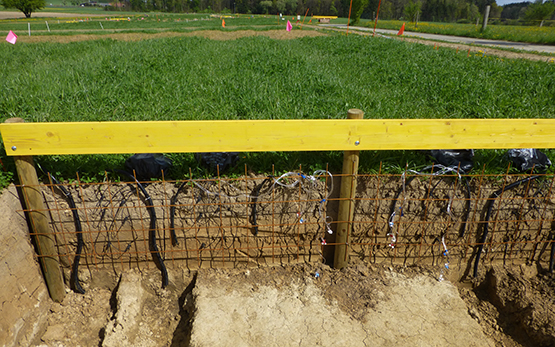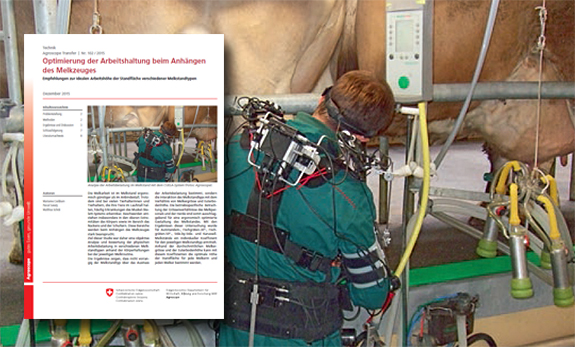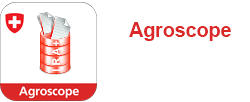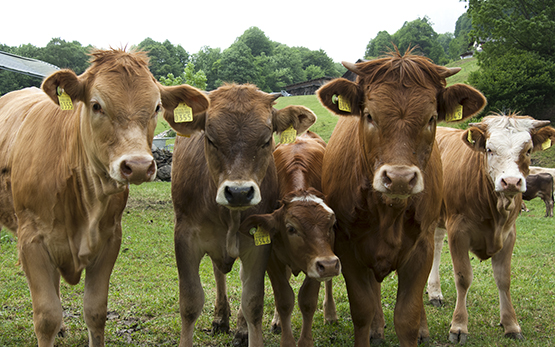Reiche A.-M., Tretola M., Eggerschwiler L., Pinotti L., Dohme-Meier F.
Former food and cocoa bean shells in early-lactating cows on a herbage-based diet: Effects on ruminal fermentation and blood metabolites.
Animal, 19, (4), 2025, Artikel 101477.
Eichinger J., Reiche A.-M., Eggerschwiler L., Tretola M., Pinotti L., Tintrop L., Fuchsmann P., Huber K., Dohme-Meier F.
Exploring exhaled volatile organic compounds as new indicators for the energy balance of dairy cows: A comparison with serum β-hydroxybutyrate.
In: GfE. 4 March, Hrsg. Gesellschaft für Ernährungsphysiologie, Göttingen (DE). 2025.
Hendricks J., Reiche A.-M., Eichinger J., Siegenthaler R., Eggerschwiler L., Silacci P., Dohme-Meier F.
Effect of a subclinical ketosis challenge on biomarkers of energy metabolism and liver function and their variability in dairy cows during the transition period.
In: 79th Conference of the Society of Nutrition Physiology. 4 - 6 March, Hrsg. Society of Nutrition Physiology, Göttingen (DE). 2025, 116.
Hendricks J., Reiche A.-M., Eichinger J., Siegenthaler R., Eggerschwiler L., Silacci P., Dohme-Meier F.
Effect of a subclinical ketosis challenge on biomarkers of energy metabolism and liver function and their variability in dairy cows during the transition period.
In: 79. Tagung der Gesellschaft für Ernährungsphysiologie. 6. März, Hrsg. Gesellschaft für Ernährungsphysiologie, Göttingen (DE). 2025.
Eichinger J., Reiche A.-M., Eggerschwiler L., Tretola M., Pinotti L., Tintrop L., Fuchsmann P., Huber K., Dohme-Meier F.
Exploring exhaled volatile organic compounds as new indicators for the energy balance of dairy cows:: A comparison with serum β-hydroxybutyrate.
In: GfE. 4. März, Göttingen (DE). 2025.
Eichinger J., Reiche A.-M., Fuchsmann P., Eggerschwiler L., Münger A., Huber K., Dohme-Meier F.
Pathway mapping of exhaled volatile organic compounds associated with blood and ruminal fluid metabolites to describe the nutritional and metabolic status of lactating dairy cows.
Journal of Dairy Science, 108, (3), 2025, 2947-2963.
Eichinger J., Reiche A.-M., Münger A., Eggerschwiler L., Pimentel G., Fuchsmann P., Huber K., Dohme-Meier F.
Usability of volatile organic compounds from exhaled breath compared with those from ruminal fluid, serum, urine, and milk to identify diet-specific metabolite profiles in lactating dairy cows.
Journal of Dairy Science, 108, (2), 2025, 1474-1494.
Guggisberg D., Zbinden D., Fehér N., Eggerschwiler L., Bosshart A., Portmann R., Egger C., Raemy M., Schmidt R.
κ-casein genotypes and minerals in raw milk and their impact on coagulation properties.
International Dairy Journal, 164, 2025, Artikel 106204.
Kasper-Völkl C., Schori F., Ampuero Kragten S., Raemy M., Siegenthaler R., Rothacher M., Eggerschwiler L.
Laufende Untersuchung des genetischen Hintergrunds der Stickstoffnutzungseffizienz und der Methanemissionen bei Schweizer Milchkühen: Erste Ergebnisse.
In: Liebefelder Milchtagung. 19. November, Hrsg. Agroscope / HAFL, Zollikofen (CH). 2024.
Kasper-Völkl C., Schori F., Ampuero Kragten S., Raemy M., Siegenthaler R., Rothacher M., Eggerschwiler L.
EffNMilk: Genetische Grundlagen der Stickstoffnutzungseffizienz beim Milchvieh: Erste Ergebnisse.
In: Nutztiertagung. 26. September, Hrsg. Agroscope, Grangeneuve (CH). 2024.
Manzocchi E., Viry L., Eggerschwiler L., Hayoz B., Schlegel P., Dohme-Meier F.
Affouragement en vert de sorgho multi-coupes : Effets sur l'ingestion, la production, la composition et l'aptitude à la coagulation du lait.
In: Rencontres Recherches Ruminants (27e édition). 4 - 5 décembre, Hrsg. IDELE / INRAE, Paris (FR). 2024, 520.
Mehaba N., Schrade S., Dohme-Meier F., Eggerschwiler L., Schlegel P.
Predictive modelling of dry matter intake in lactating dairy cows based on routinely available variables.
In: 75th EAAP Annual Meeting. 1 September, Hrsg. EAAP, Florence (IT). 2024, 1.
Mehaba N., Schrade S., Dohme-Meier F., Eggerschwiler L., Schlegel P.
Predictive modelling of dry matter intake in lactating dairy cows based on routinely available variables.
In: 75th EAAP Annual Meeting. 1 - 5 September, Hrsg. EAAP, Florence (IT). 2024, 357.
Manzocchi E., Viry L., Eggerschwiler L., Hayoz B., Schlegel P., Dohme-Meier F.
Green-cut sorghum fed indoor to dairy cows: A strategy to mitigate herbage shortages?
In: 75th Annual Meeting of the European Federation of Animal Science. 1-5 September, Hrsg. EAAP, Florence (IT). 2024.
Wang K., Räisänen S. E., Eggerschwiler L., He T., Islam M. Z., Li Y., Ma X., Siegenthaler R., Zeng Z., Dohme-Meier F., Niu M.
Feed intake regulation stabilized daily pattern of intake with little impact on rumen fermentation or methane mitigating efficacy of 3-nitrooxypropanol (3-NOP) in dairy cows.
In: ADSA Annual Meeting. 16-19 June, Hrsg. American Dairy Science Association, West Palm Beach, Florida (US). 2024, 78.
Pontiggia A., Eggerschwiler L., Reiche A.-M., Keil N., Dohme-Meier F.
Effect of shade availability on the physiological responses, water intake, and feeding behavior of grazing cows with an increasing heat load.
In: ADSA Annual Meeting. 16-19 June, Hrsg. American Dairy Science Association, West Palm Beach, Florida (US). 2024, 249-250.
Mehaba N., Schrade S., Dohme-Meier F., Eggerschwiler L., Schlegel P.
Evaluation of different models predicting dry matter intake in multiparous lactating dairy cows.
In: Role of animal nutrition in sustainability goals for Switzerland and beyond. 23 May, Hrsg. ETH Zürich, Lindau. 2024, 42-43.
Guggisberg D., Egger C., Bosshart A., Fehér N., Eggerschwiler L., Schmidt R., Portmann R.
Impact of κ-casein phenotypes on chymosin-induced milk coagulation properties: Application of diffusing wave spectroscopy.
In: International conference for cheese science and technology (Bergen, 3.-7.6.2024). 3. June, Bergen. 2024.
Wang K., Räisänen S.E., Eggerschwiler L., He T., Islam M.Z., Li Y., Ma X., Siegenthaler R., Zeng Z., Dohme-Meier F., Niu M.
Feed intake regulation stabilized daily intake pattern but reduced lactational performance with little impact on rumen fermentation or efficacy of 3-nitrooxypropanol (3-NOP) in dairy cows.
In: Role of animal nutrition in sustainability goals for Switzerland and beyond. 23 May, Hrsg. ETH Zürich. 2024, 42.
Guggisberg D., Egger C., Bosshart A., Fehér N., Eggerschwiler L., Schmidt R., Portmann R.
Impact of genetic κ-casein variants (A, B, E) on chymosin-induced milk coagulation properties: Application of a new LC–MS-based genotyping method.
International Dairy Journal, 155, 2024, Artikel 105973.









